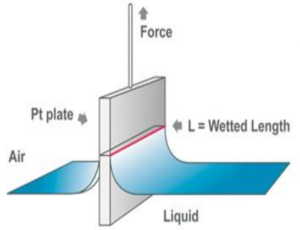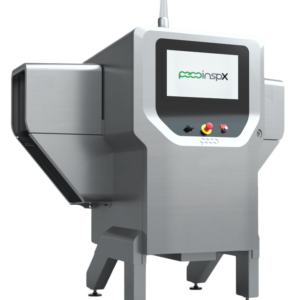Contact Angle from Surface Electro Optics
What is Contact Angle?

The Contact Angle is well-known technique for investigating and controlling adhesion, surface treatments and cleaning, and polymer modification.
The contact angle is the angle between the tangent to the drop’s profile and the tangent to the surface at the intersection of the vapor, the liquid and the solid.
The wetting of solid substrates is basic feature of many natural and industrial processes, The contact angle is an index of the wettability of the solid surface and a simple, rapid and sensitive method of characterizing of the wettability. The low contact angle generally indicates that the surface of the substate is hydrophilic and has a high surface energy / good wetting property. Conversely, a high contact angle means that the surface is hydrophobic and has a low surface energy / poor wetting property.
Methods for Surface Tension
Du Nòuy Ring (Platinum-Iridium) Method
 The Du Nòuy ring method is commonly used to determine the surface tension of a liquid-vapor interface or the interfacial tension of a liquid-liquid interface. This information is critically important for applications such as detergency and emulsification and is also important for many biological processes.
The Du Nòuy ring method is commonly used to determine the surface tension of a liquid-vapor interface or the interfacial tension of a liquid-liquid interface. This information is critically important for applications such as detergency and emulsification and is also important for many biological processes.
The method involves pulling the Du Nòuy Ring through the liquid/vapor interface and measuring the maximum downward force directed to the Pt-Ir ring. The surface tension is calculated based on the maximum force measured and the parameters of the ring.
Wilhelmy (Plate) Method

The Wilhelmy plate technique provides the most accurate and repeatable measurements. In the Wilhelmy method, the plate is hung perpendicular to the liquid’s surface. It involves placing a thin Pt plate or clean glass into the test liquid and measuring the force acting on the plate when the system is at equilibrium.
Pendant Drop Method
 The test liquid is injected by a syringe to form a drop on the tip of the needle. The drop is captured by a CCD camera, and the surface tension is measured from the shape of the drop. This method is typically used for measuring surface tensions of liquids with high viscosity or at elevated temperature/pressure. The SEO Contact Angle equipment uses the Bashforth-Adams technique for calculating the surface tension based on the droplet shape.
The test liquid is injected by a syringe to form a drop on the tip of the needle. The drop is captured by a CCD camera, and the surface tension is measured from the shape of the drop. This method is typically used for measuring surface tensions of liquids with high viscosity or at elevated temperature/pressure. The SEO Contact Angle equipment uses the Bashforth-Adams technique for calculating the surface tension based on the droplet shape.
Static / Dynamic (Sessile Drop) Contact Angle Analyzer
Portable Type: Phoenix-i

-
CA range: 3–180°
-
Easy to use with USB camera
-
Measures: Contact angle, surface energy, pendant drop
Compact Type: Phoenix-Alpha

This system is designed for simplicity, compactness, and space efficiency.
-
CA range: 0–180°
-
Sample size: Up to 100 × 50 mm
-
Drop control: Automatic / Manual
-
Measures: Contact angle, surface energy, pendant drop
General Type
This system is designed to offer the flexibility required for scientific research & engineering process development.
-
CA range: 0–180°
-
Illumination: White LED module
-
Sample size: Up to 300 × 200 mm
-
Measures: Contact angle, surface energy, pendant drop
Manual Drop Type: Phoenix 150
-
Manual drop control by precision screw
-
Upgradeable to automatic drop and touch-off system

Automatic Drop Type: Phoenix 300
-
Drop control: Manual / Semi-automatic / Automatic (software-controlled)
-
Upgradeable to touch-off system
Wide Size: Phoenix 300plus (300 × 300 mm size)
-
Drop control: Manual / Semi-automatic / Automatic (software-controlled)
-
Upgradeable to touch-off system
Touch Drop Type: Phoenix 300Touch

This system features a Touch-off system for precise sample surface contact.
-
CA range: 0–180°
-
Sample size: Up to 200 × 50 mm (height)
-
Drop control: Automatic touch system (software-controlled) + Manual drop control
-
Measures: Contact angle, surface energy, pendant drop
Pico/Nano Drop Type: Phoenix-Pico
![]()
This drop-shape analyzer is optimized for extremely small samples (e.g., BGA, hair, fiber) and electronic/semiconductor applications.
-
CA range: 0–180°
-
Drop control: Piezo-electric precision control (drop size: 70 pico- to microliters)
-
Measures: Contact angle, surface energy, pendant drop
OEM Type: Phoenix 600

This fully customizable system provides precise X-, Y-, Z-axis movement and rotation for accurate sample positioning.
-
CA range: 0–180°
-
Sample size: Up to 400 × 400 mm
-
Drop control: Automatic touch system (software-controlled) + Manual drop control
-
Measures: Contact angle, surface energy, pendant drop
High Temperature Type: Phoenix-HT

Designed for analyzing glass, metals, ceramics, and alloys under high-temperature conditions (vacuum or controlled atmosphere).
-
CA range: 1–180°
-
Temperature range: Ambient to 1200°C (up to 1800°C optional)
-
Features: Automatic imaging, data recording, and video capture
-
Measures: Contact angle, wettability, surface energy
FPD (LCD/OLED/PDP/Wafer) Contact Angle Analyzer
CTA Model Series (470, 930, 1300, 1500, 2000, 2500)

Ideal for evaluating surface cleanliness and treatment processes in wafers, FPDs (LCD, OLED, PDP), and related applications.
-
CA range: 5–180°
-
Sample size: 300 × 300 mm to 2500 × 2500 mm (or larger)
-
Measures: Contact angle, surface energy, wettability
Contact Angle Accessories
-
Full Instrument Tilt Stage (0–90°)
-
Manual Tilt Stage (0–90°)
-
Temperature Chamber (Ambient to 250°C)
-
Thermal Pad (Ambient to 250°C)



